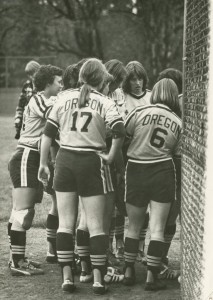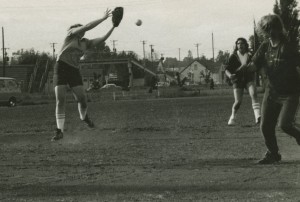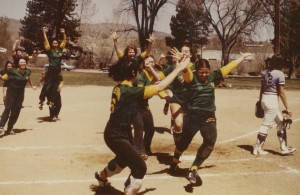UO Women’s Softball — Part II: The Early History of the Program

UO Special Collections and University Archives, in collaboration with Oregon Softball and the Women In Flight program, presents a three-part series this week detailing the early history of Oregon women’s softball in celebration of the last regular season games this weekend at Howe Field (1936-2015). Part I focused on the career of Becky Sisley, former women’s athletic director at the University of Oregon, and her contributions to the growth of women’s athletics on campus; today features a look at the rise of softball in the 1970s in the wake of Title IX legislation; and tomorrow’s post will detail the development of UO’s first dedicated softball field in 1979.
During Becky Sisley’s early years at the University of Oregon, softball and other women’s competitive sports and other Women’s Recreation programs received only limited funding from the Incidental Fee Committee. The formation of the Northwest College Women’s Extramural Association (later NCWSA) in 1966 began the process of legitimizing and formalizing policies governing intercollegiate competition for women. The softball interest group’s 1966 budget totaled $37.32 in Sisley’s first season as coach. Women’s sports were beginning to be recognized in the late 1960s as regional competition and national championships were initiated for several sports, but not softball.
1972 would be an auspicious year nationwide for females as the U.S. Congress passed Title IX legislation on June 23. This federal law mandated gender equity in all educational programs, and sports presented the arena where discrimination was most blatant. The University of Oregon and all public universities were confronted with the realities of reaching compliance. However, the regulations to implement Title IX were not promulgated until 1975. Then universities were required to conduct a compliance review of all programs across campus and thus reviewed its athletic programs in relation to Title IX compliance.

Still under the aegis of the Department of Physical Education rather than the Athletic Department, softball players and other female student-athletes were still fighting for acceptance and institutional support; women’s sports were still dependent on incidental fees allocated by the ASUO for their annual budgets, and athletic scholarships were unavailable to women.
The 1975-1976 Title IX Task Force Report brought to light the gap in the institution’s support for women’s athletic programs and numerous gender equity concerns across the campus. As Sisley and others fought to narrow that gap, women’s sports began to rise in prominence. Sisley coached two teams of softball players at the same time from 1971 until a GTF assistant, Francis Flint, was added in 1975. The teams were initially called A and B teams rather than varsity and junior varsity. From 1966 through 1973, the team played fewer than ten games annually with other Oregon institutions. The first NCWSA softall competition was held in 1974 as an invitational tournament just for southern area schools. Institutions in other parts of the northwest did not yet have intercollegiate softball.

By the mid-1970s softball practices began during winter term to get a head start to the spring competition. By this time some incoming freshman arrived on campus with summer softball experience playing on ASA teams. However, high schools had not yet started interscholastic programs. Because of this lack of high-school training, the summer experience led to better skill level of varsity players.
Oregon softball’s breakthrough finally arrived in 1976. As the United States celebrated its bicentennial, the Ducks compiled a 16-6 record to claim the school’s victory in the first NCWSA Invitational Tournament. They went on to represent Oregon at the Women’s College World Series for the first time. Oregon qualified for the trip to Omaha in a best-of-three series against rivals Oregon State. After the Beavers knocked off Oregon 5-1 at Amazon Field in Eugene, the Ducks rebounded to win two straight in Corvallis for the Northwest’s berth in the national tournament. Sisley’s crew dropped its opening game in the double-elimination tournament 5-1 to Minnesota; they went on to best South Dakota’s Mayville State 11-0 in their second game, but then lost 14-6 to Indiana State to exit the tournament.

The evolution from interest group to varsity sport progressed smoothly into 1977. That spring, Women’s Intercollegiate Athletics was merged into the existing Athletic Department, creating a single structure to oversee all intercollegiate athletics at the University of Oregon. In the fall, limited scholarship money became available for female student-athletes. The university began to identify ways that it could reduce and mitigate the facility inequities and lack of a women’s athletics support staff that had been identified during the Title IX compliance review. Yet, softball was the only sport that did not have a facility for competition on campus.
Though they failed to return to the 1977 AIAW national tournament, as Oregon State swept their best-of-three series to determine which of the two Civil War rivals would earn the trip to Omaha, the Ducks recovered from the disappointment to repeat their success in the NCWSA Invitational Tournament. The team suffered a setback in 1978 when they lost their first 10 contests on the way to a 4-13 finish. Brighter times, however, awaited in the near future. In addition to having a GTF assistant coach for the team as early as 1975, softball would finally have hope of getting their own field on campus.
Information for this article was collected from the following sources:
- “1970s-1980s: Title IX Era at Oregon,” Leadership and Legacy: Athletics at the University of Oregon, accessed April 16, 2015, http://sportshistory.uoregon.edu/topics/the-universitys-response-to-title-ix/evolution-of-womens-sports-at-oregon/1970s-1980s-title-ix-era-at-oregon/.
- “The Early Years for Women (1890s-1970),” Leadership and Legacy: Athletics at the University of Oregon, accessed April 16, 2015, http://sportshistory.uoregon.edu/topics/the-universitys-response-to-title-ix/evolution-of-womens-sports-at-oregon/the-early-years-for-women-1890s-1970/.
- “Oregon’s modern softball history starts with one-hour game,” Oregon Sports (Eugene), May 4, 1979, 3.
- “Softball Media Guides, 1978-1991,” University Archives sports information and media guides, UA Ref 5, Box 26, Special Collections & University Archives, University of Oregon Libraries, Eugene, Oregon.
- “Women: Softball Field,” University Archives alphabetical subject files, UA Ref 1, Box 16, Special Collections & University Archives, University of Oregon Libraries, Eugene, Oregon.
- Goss, Lauren. Femininity and Athleticism: Title IX at the University of Oregon (University of Oregon: Honors Thesis, 2011).
- This post has been periodically edited thanks to additional insights from Becky Sisley.
Zach Bigalke
Student Research Assistant

